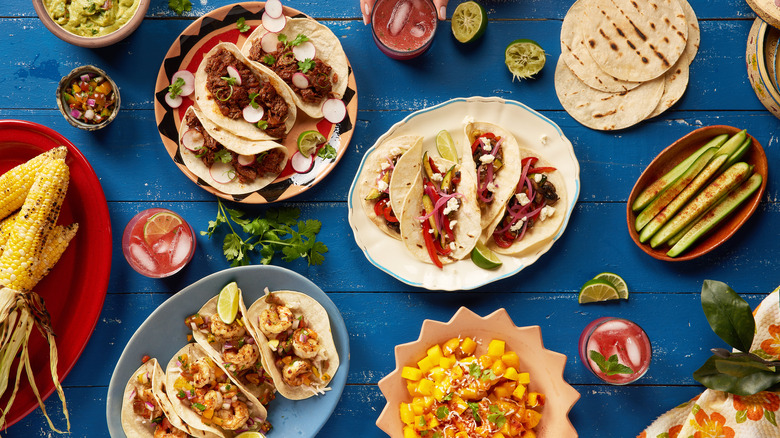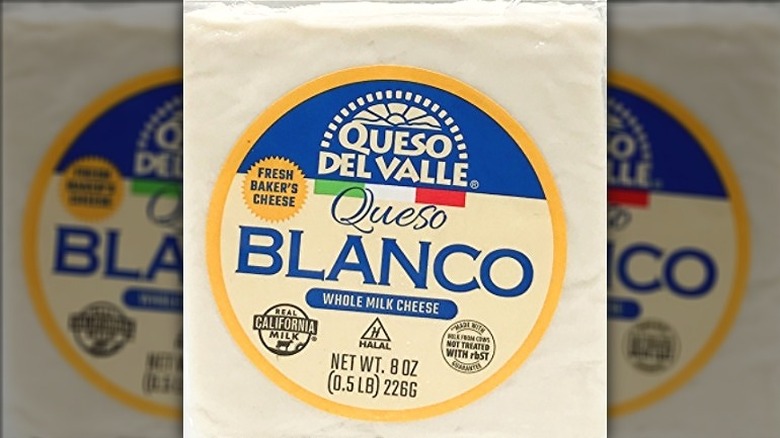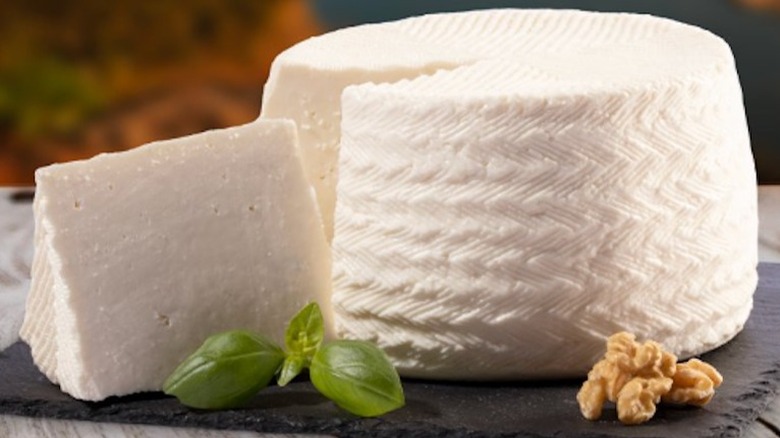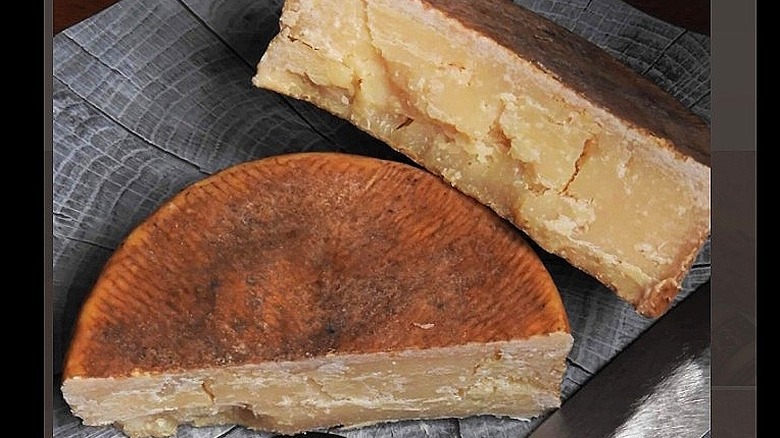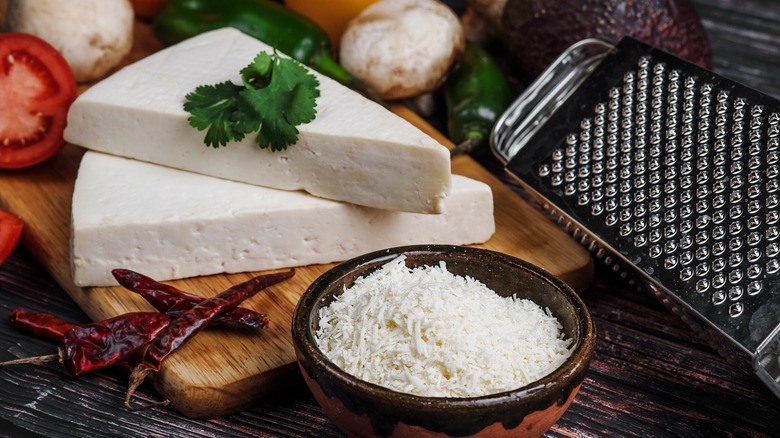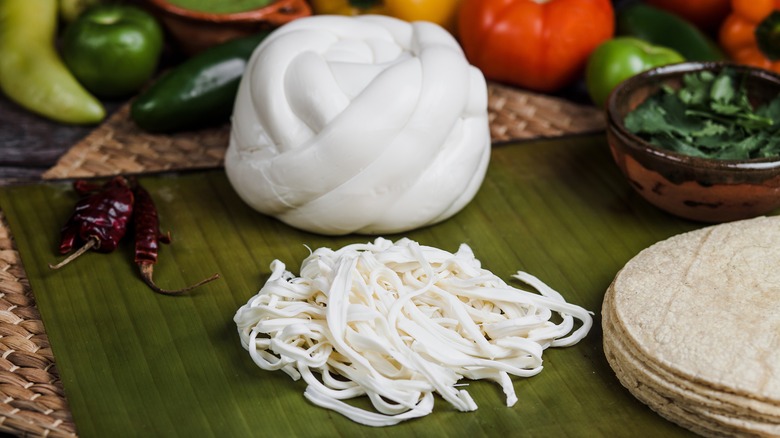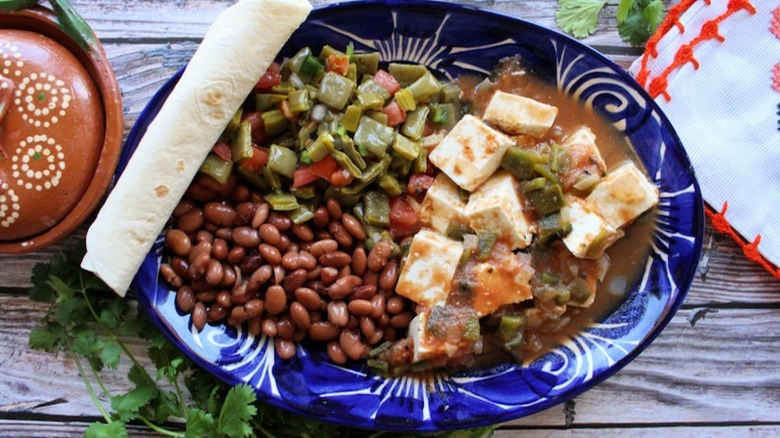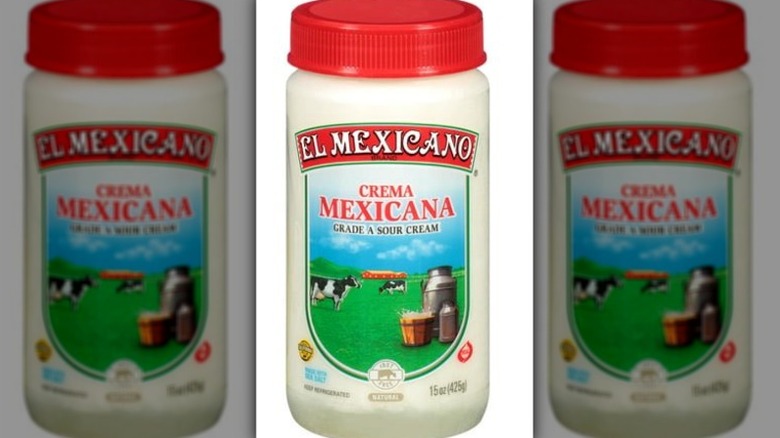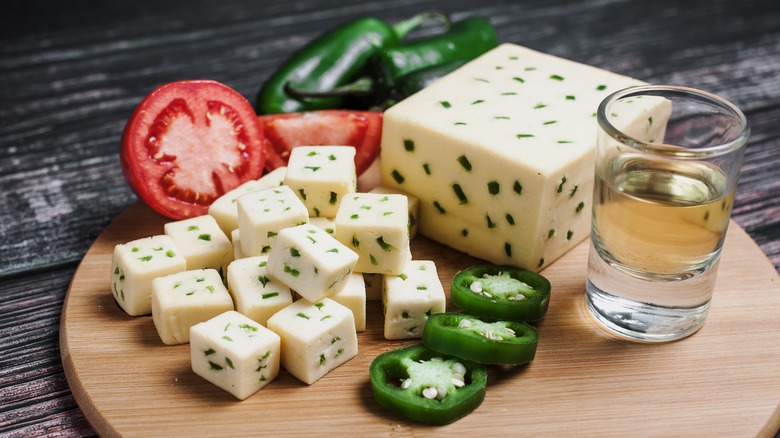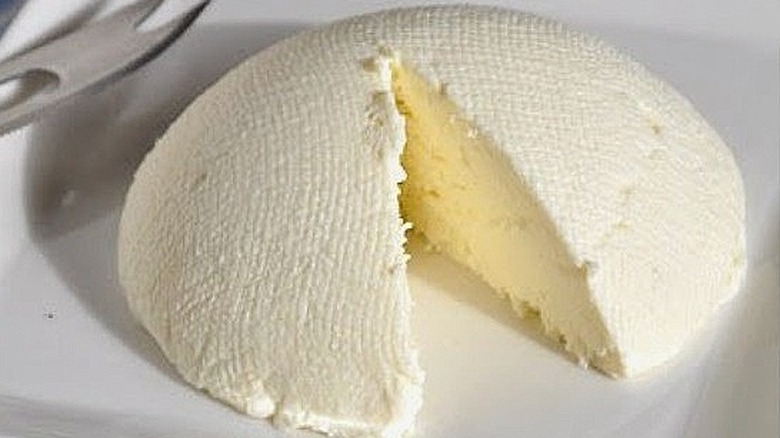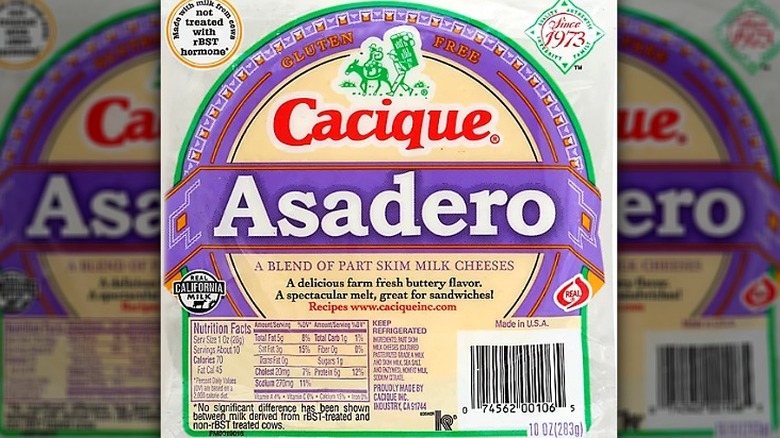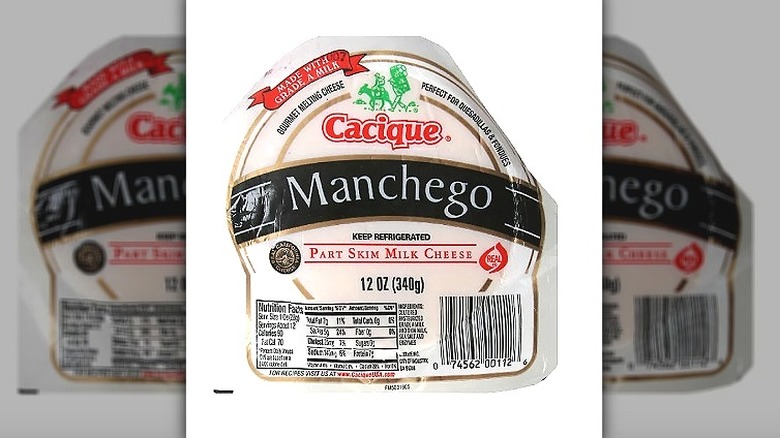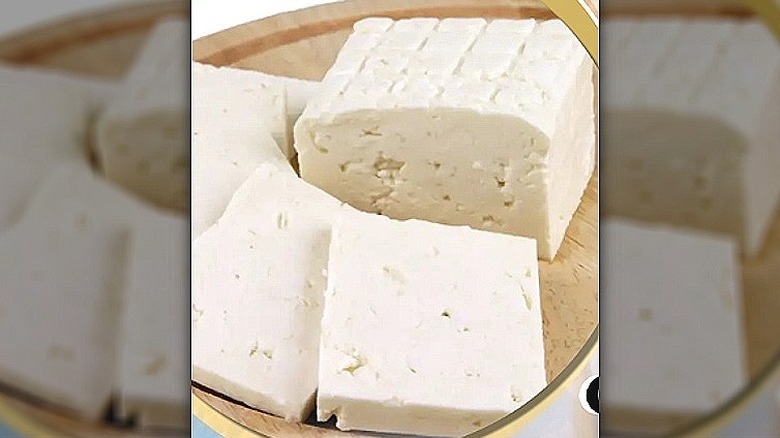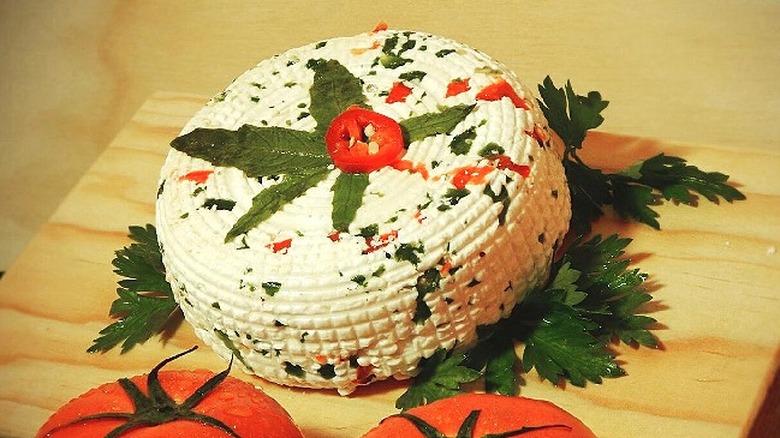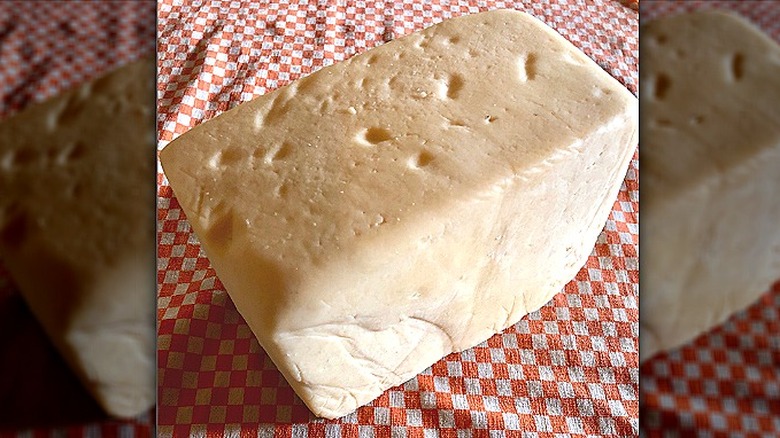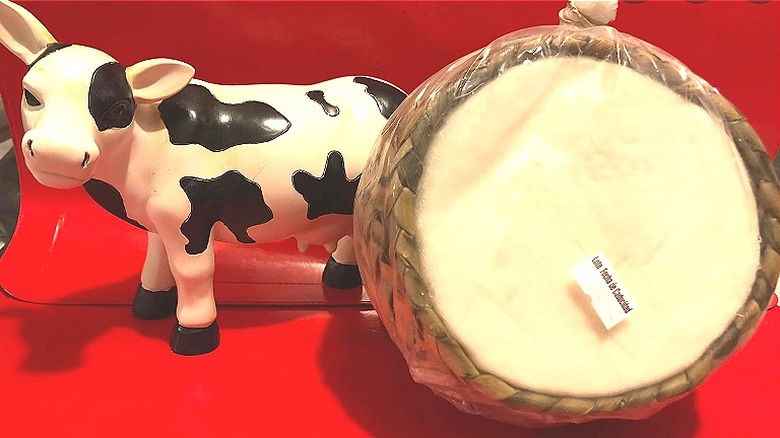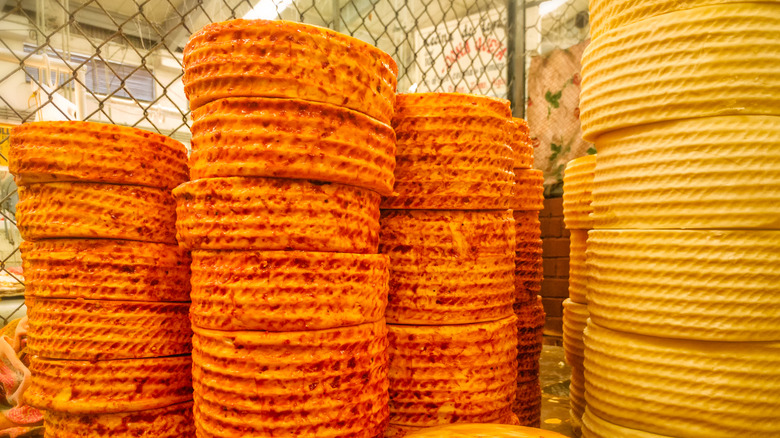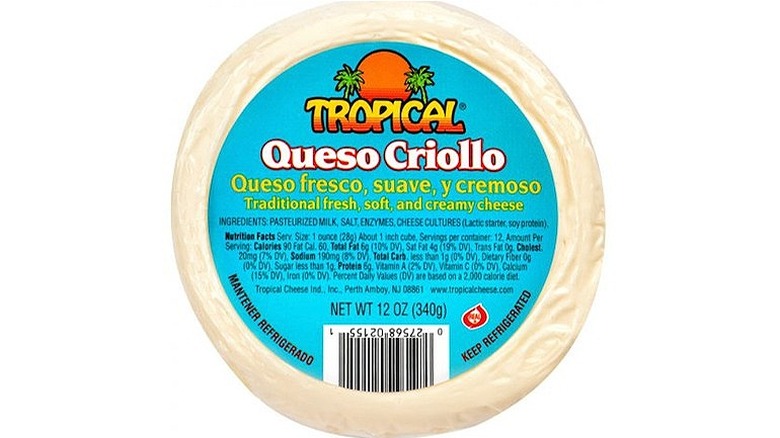The Ultimate Guide To Mexican Cheeses
Cheese is big business in the U.S. Per capita cheese consumption has been rising since 2000 (via Statista). The average American today consumes around 40 pounds of cheese annually. Paired with the rise in popularity of Mexican cuisine, this has created an increased demand for a more diverse portfolio of Mexican food items (via Beyond Borders Gazette). Indeed, Mexican food is now considered the second most popular ethnic cuisine in America, behind Italian cuisine. One common thread between the two? Both cultures love to use cheese in dishes!
The driving factor behind this trend is likely multi-faceted. Mexican food is known to be a quick, affordable, and delicious meal option. However, the influx of immigrants from Mexico to the U.S. is also a central factor (via Salon). As these immigrants settle into their homes, their desire to consume familiar foods produces a demand for authentic ingredients at grocery stores and restaurants. Increased demand and Americans' curiosity about ethnic foods crafted a need for authentic ingredients to be made available.
This is great news for turophiles like us. However, we like to be informed consumers, so we're diving into understanding more about the history, individual flavor profiles, textural variations, and uses of various kinds of Mexican cheeses. Here's a comprehensive list of the wonderful world of Mexican cheese to help guide those curious to learn more ways to introduce cheese into dishes.
Queso blanco
Like many staples of Mexican cuisine, queso blanco was born out of the cheesemaking culture brought to Mexico by the Spanish in the 1800s (via Mexico Cheese). Queso blanco translates to "white cheese" and is a fresh, slightly salty, crumbly cheese — similar to a cross between feta and ricotta. According to Culture, the process of making queso blanco is simple. Fresh cow's milk comes to a boil and is then curdled with an acid-like vinegar or lemon juice. After straining the curds, the cheese is ready to serve within a couple of days.
Due to its slight acidity and mild flavor, queso blanco tames the heat of chilis in spicy dishes. It also holds up quite well to heat, yielding a velvety texture when used atop enchiladas or beans. When used fresh, it can be crumbled over salads and tacos or served whole with a dollop of guava or tomatillo jam.
Queso fresco
Like queso blanco, queso fresco is another farmer's cheese that evolved from the cheesemaking culture imported to Mexico by the Spaniards in the 1800s (via Mexico Cheese). Translated to "fresh cheese," the texture and flavor of queso fresco are almost indistinguishable from queso blanco. However, its production is distinct. Queso fresco uses a combination of cow and goat's milk. Additionally, queso fresco introduces rennet to the milk to separate the curds from the whey, per Wisconsin Cheese. Vegetarians can eat queso blanco, but not queso fresco.
The slightly salty, acidic, crumbly cheese is ideally consumed within a few days to taste it at peak quality. Masterclass recommends using it atop antojitos, or "little cravings," which are bite-sized snacks made by street vendors similar to tapas. Common antojitos include chilaquiles, chalupas, elotes, tlacoyos, and tamales. We also love substituting it for feta for a slightly milder flavor and softer texture.
Queso añejo
The word añejo translates to "aged." This cheese, also known as añejo enchilado, is a semi-hard, salty, and spicy cheese that shreds beautifully as it ages. It can be made of either cow's or goat's milk and coated with a thick layer of smoked paprika as protection before aging, creating a bright reddish orange-hued rind (via Cheesemakers.com). Generally, this cheese is in a shredded format. But if you can get your hands on a block of it and shred it yourself, we recommend it, as the quality will be superior.
As its alternate moniker suggests, this cheese is ideal for enchiladas but works well with nachos, quesadillas, and even as an alternative to mozzarella on a homemade pizza. Some variations may combine chili powder with paprika to create an even spicier version to use as a topping on a bowl of steaming hot chile con carne.
Cotija
Cotija cheese is also called the "Parmesan of Mexico" (Cheese.com). This cow's milk cheese has been made the same way since the 16th century, garnering it Denominacion de Origen or DDO status (via Mexico Cheese). Its name derives from its town of origin, Cotija de la Paz, located in the Mexican state of Michoacàn.
Traditional Michoacan-style cotija cheese is ultra-salty with a pungent smell and tough rind. It crumbles easily, and because it lacks moisture, it doesn't melt. Heated unpasteurized cow's milk, salt, and rennet combine to make this ingredient. Once strained and set into molds, it ages from three months to several years. Fresh cotija has a texture similar to ricotta salata, so it works well in salads or atop tacos. Older cotija becomes hard and is ideal for grating as a garnish over several dishes, including pasta.
There are three artisanal variations of note: Jalisco-style, Querétaro-style, and Chiapas-style. Jalisco-style cotija is more supple and can easily be cut into pieces to be thrown on the grill or into a pan for a quick sauté. Querétaro-style is also a firm cheese that works great for grilling or pan-frying, but it also has the unique property of a rind made of a combination of dried chilis, vinegar, and garlic. Chiapas-style cotija is the least salty of the bunch and has the firmest texture.
Queso Oaxaca
Queso Oaxaca — sometimes known as quesillo — is a semi-soft cow's milk cheese derived from the Oaxaca region of Mexico (via Mexico Cheese). The state of Oaxaca is known for its rich culinary heritage based on the Indigenous traditions of the Zapotec and Mixtec and fueled by the distinct microclimate of the region, per Authentic Food Quest. One of its most legendary dishes is molé, the unctuous complex chocolate-based sauce that can take days to prepare. The sophistication of the culinary tradition of Oaxaca is indicative of the delicacy that is queso Oaxaca.
Its similarity to mozzarella speaks to its origins. Dominican monks from Italy brought the pasta filata cheesemaking process to Mexico. Pasta filata is made by heating the cow's milk and adding rennet to separate the curds from the whey. After cutting the curds, they're drained and transferred to hot water. As they melt, the curds are slowly worked by hand, pulled, and extended into their characteristic ribbon-like strands. These strands are then bound into a ball and transferred to a saltwater bath.
The flavor of queso Oaxaca is somewhat of a cross between mozzarella and Monterey jack. Like mozzarella, it is an ideal melting cheese and has a texture very similar to American string cheese. It is commonly found in dishes like quesadillas, tlayudas, and queso fundido. But it can be used in any application where you need a great melting cheese.
Panela
Panela — also known as "queso canasta" or "queso de la canasta" — translates to "basket cheese." The ingredient is thought to be a variation of a similar type of cheese found in Greece, according to Mexico Cheese. It gets its distinctive basket shape thanks to the way in which it is produced. After adding rennet, part-skim cow's milk becomes heated and separated into curds and whey. Once the curds are cut, separated, and salted, they're transferred into a basket to set.
This type of cheese belongs to the family of grilling cheeses, which includes Indian paneer and Greek halloumi. Grilling cheeses are notable for retaining their shape when exposed to heat without melting. Its flavor tends to be on the salty side. Although it doesn't have to, it can have a kind of squeaky property when you bite into it. When baked or fried, this cheese works well as a filling for sandwiches — like a cemita or torta — or it can be garnished with a spritz of lime juice and cilantro for an appetizer like Greek saganaki.
Crema
According to Cheese.com, crema Mexicana is a fermented milk product that has a flavor and texture somewhat similar to a cross between sour cream, crème fraîche, and Greek yogurt. While you can purchase it in virtually every grocery store that has a Mexican food section, you can also make a facsimile of it at home. Although it is a suitable garnish for fruit, it is more typically utilized in savory applications (via Masterclass).
Due to its high-fat content, crema can be directly added to hot dishes without curdling, unlike sour cream. It is the perfect complement to spicy foods and can provide a refreshing tang to heavier dishes like nachos or tostadas. For a textural variation with fried foods, crema can be used to create a light sauce. Crema is uniquely suited to pair well with avocado for a variation on guacamole. It really is a versatile condiment that can easily be incorporated into any dish that calls for a creamy component.
Chihuahua cheese
Queso Chihuahua is a cow's milk cheese historically produced by the Mennonite communities residing in the Northern Mexican region of Chihuahua (via Cheese.com). Often called Campresino Menonita, this semi-soft cow's milk cheese can come from pasteurized or raw milk. The term "campresino" distinguishes the cheesemaking method used by the Mennonites, which is a compression technique also used to manufacture cheddar cheese.
According to a study published in Science Direct, the flavor, and texture of this cheese varies between cheeses made with raw versus pasteurized milk. Seasonal times of the year can influence the fat and microbial content of the milk obtained from pastured cows. Typically, raw milk cheeses are gamier in flavor with a softer consistency than those made from pasteurized milk.
Regardless of origin, however, this cheese is consistently darker in color compared with many of the other cheeses produced in Mexico. Its amber hue is indicative of the butteriness that often characterizes this cheese. Its ability to melt is intrinsic to its utility in baked dishes like pizza, lasagna, or casseroles. Queso Chihuahua is also a great option for a classic cheese fondue.
Requesón
Requesón (or Requeijão) is a ricotta-like cheese made of cow, goat, or sheep's milk, with origins in Portugal and Brazil — although it can be found all over Latin America, including Mexico (via Mexico Cheese). The cheese is made by supplementing cheese curds with whey, which is subsequently heated, strained, and then sits in wicker-like baskets (via Cheese.com).
According to WikiCheese, the Portuguese version is usually stronger in flavor with a firmer consistency. The Brazilian version is more akin to cream cheese, but it doesn't have the flavor profile that a traditional American cream cheese would. This cheese is most often used in dishes like enchiladas or as a substitute for ricotta in a classic lasagna. It can be jazzed up with the addition of hot chilis and fresh herbs like cilantro for a savory tapa. Or it can be turned into a sweet treat by donning it on toast and garnishing it with chopped nuts and honey.
Queso asadero
According to On The Gas, queso asadero is a string-cheese-like product that originates from the state of Chihuahua in the northern part of Mexico. The ingredient uses a similar cheesemaking method as queso Oaxaca — namely the pasta filata method. While the two share similarities in texture, the flavor of asadero cheese is less mozzarella-like and more akin to a Monterey jack or provolone. It is also typically not as firm in texture as its Oaxacan cousin.
Asadero is generally sold in logs, sliced, or shredded (via Mexico Cheese). There is also a variation that embeds jalapeño chilis into the mix. Whichever way you purchase it, it is the ideal melting cheese and an essential component in a queso fundido — not to mention a fabulous cheese for homemade nachos. If you're planning on making a taco pizza, look no further than asadero as a base for this American classic.
Manchego
Like Parmigiano Reggiano, Manchego is a cheese that has become the center of heated debate. It originated in Spain and has been protected under European law since 1984 (per Culture). The term "Manchego" has received DOP (Protected Designation of Origin) certification, meaning that only cheese produced in the La Mancha region of Spain, using sheep's milk from the manchego breed of sheep can be called "Manchego." However, since this designation is not recognized outside of the EU, cheeses manufactured in other countries can slap the name on their label and sell their products. This is exactly what has occurred with Mexican manchego (via Mexico Cheese).
Mexican manchego comes from pasteurized cow's milk and is mass-produced to keep up with the demand for this popular cheese. Unlike the classic Spanish version, Mexican manchego is rindless, has an amber color, and has a flavor similar to mild cheddar. It is often sold in pre-packaged slices and may contain additives and preservatives intended to maintain shelf-life. It is most frequently used in sandwiches like grilled cheese or as a melting cheese for dishes like quesadillas, enchiladas, or molletes.
Chontaleno
According to Cheese.com, Chontaleno is a semi-hard cheese, made with pasteurized cow's milk. Although it is a Mexican cheese, it is categorized as being a part of the parmesan family thanks to its firm texture and salty flavor. As with other cheeses made in the parmesan style, it cannot be called real parmesan cheese since it isn't produced in the Emilia Romagna region of Italy using local milk and cheesemaking techniques in accordance with DOP certification.
That being said, its uses are similar to classic parmesan cheese. While it is a fabulous cheese to be included on a charcuterie board, it is also ideal to grate as a garnish over dishes like pasta. Additionally, chontaleno comes in a smoked variety known as "Ahumato," which has a marvelous robust flavor that pairs well with strong spices common in Mexican cuisine. (When we conducted a search for where to purchase this cheese, retailers selling it only had a Nicaraguan version of it, which we presume is similar in flavor and texture to the Mexican version.)
Queso de bola
According to the Slow Food Foundation for Biodiversity, queso de bola, or "ball-shaped cheese" is produced in the town of Ocosingo in the northeast region of the state of Chiapas. For generations, it has been manufactured by small family farms. Similar in style to an Italian caciocavallo, this cheese seemingly originated in the late 1800s. During this time, Dutch-made Edam cheese made its way through the ports off the Yucatan peninsula, spreading its style of cheesemaking throughout Mexico. However, there are some questions surrounding this origin story since queso de bola bears little resemblance to a Dutch Edam.
Queso de bola comes from raw cow's milk. It's unusual for being made up of two distinct kinds of cheese, layered over one another. The exterior becomes a thick casing for a creamy yellow paste inside. This paste is slightly salty and typically scooped out of the center of the cheese by cutting off the top of the hard casing. Another common method of eating this cheese is to fill the center of it with meat and then bake it, creating a cheesy meat pie.
Botanero
Botanero cheese is a soft, salty, raw cow's milk cheese native to the central highlands of northwest Mexico (via Life Persona). Its name comes from the Mexican word for "appetizer" or "botana." This cheese is frequently consumed with alcoholic beverages at parties. It is distinct in that it is often flavored by adding various chili peppers during the cheese-making process. Another variation involves the incorporation of a blend of Mexican herbs known as epazote, containing ham, sausage, sesame seeds, and more. Due to the use of milk obtained from a breed of Holstein cattle that favors the rainy season for milk production, this cheese is only available seasonally.
Considering how the raw milk production process of this cheese, it has a high preponderance of bacterial contamination. Some research suggests that the use of chilis may confer some antibacterial qualities. However, in its current form, caution is recommended prior to consumption.
Adobera
According to Mexico Cheese, Queso Adobera is a cow's milk cheese typical of the western part of Mexico in the state of Jalisco. This cheese gets its name from its shape, which is reminiscent of adobe bricks. Its flavor is mild with hints of acidity and a salty bite. Since it's unripened, it has a supple texture and a pearly color. While it crumbles easily, this cheese slices well and melts beautifully. It is commonly infused with specks of chili peppers and sometimes marinated in adobo spices for an extra pop of flavor. However, it's most frequently used in quesadillas or queso fundido.
Due to its raw milk base, queso adobera is not frequently found outside of Mexico (via Scope Database). Research and analysis of samples of this type of cheese have indicated that because this cheese exists in lightly fermented small batches, it does not pose a significant threat of bacterial contamination like other raw milk cheeses.
Tenate
Queso tenate is a semi-soft artisanal cow's milk cheese that has been produced for more than 100 years in the state of Tlaxacala, Mexico (via Mexico Cheese). The smallest state in Mexico, Tlaxacala is in the central portion of the country, in an area once inhabited by the Olmeca-Xicalanca civilization (via History). Part of the coat of arms of the region features green palm fronds, which represents victory. These palm fronds are an integral aspect of the craftsmanship involved in making tenate cheese.
The word "tenate" describes a basket woven of these victorious palm fronds in which the cheese is placed to age. As a result of this encasement, the cheese has a distinctive aroma redolent of palm fronds. It's rindless with a salty and buttery flavor. Most eat this cheese fresh. But a small quantity can be reserved for dry seasons. Tenate has a similar texture and utility to queso blanco.
Cincho
According to Mexico Cheese, queso de cincho is a unique cheese made in the state of Guerrero, Mexico. The state of Guerrero is perhaps most well-known for tourism to the beaches of Acapulco and Ixtapa (via History). In addition to tourism, this region is rich in natural resources, and a mecca for fishing, agriculture, and livestock.
Queso de cincho gets its moniker due to its distinctive shape, resembling a wheel that looks as though it has been cinched by a belt. It is an artisanal cheese made with raw cow's milk in small batches. Its texture is on the firmer side with a salt-forward flavor and a hint of herbal notes. Cincho is a cheese that is not ideal for melting, as it tends to become tender without liquefying when heated. Since it's such a niche product, this cheese is seldom seen outside of Mexico, and, therefore, is best appreciated when visiting the street markets on holiday.
Criollo
Queso criollo is a specialty from Taxco, Guerrero (via Mexico Cheese). Per CNBC, the village of Taxco is known as one of Mexico's "pueblos magicos" or "magic villages." However, its stunning beauty might be outmatched by its unique culinary scene, where pozole is the focus. This dish of hominy and pork can only be made better with the addition of some queso criollo. This raw cow's milk cheese is one of the only yellow cheeses found in Mexico.
Its texture and flavor are so similar to a muenster cheese, so you can easily substitute one for the other. Although some international food distributors attempted to develop a commercial brand of criollo to export, it is seldom comparable in flavor or texture to the authentic version. It is recommended that if you are searching for a suitable alternative in a Mexican grocery store, opt for a queso chihuahua or a Mexican manchego.
